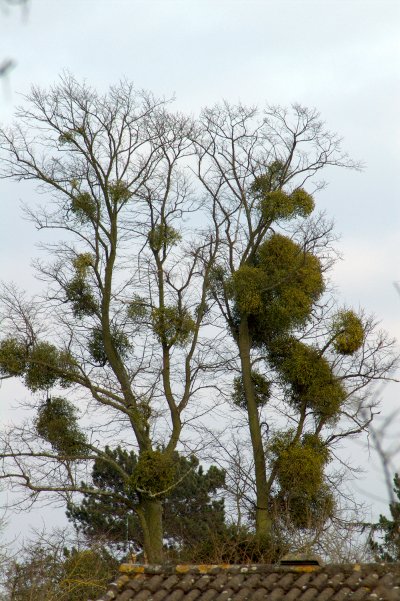There are over 1,500 species of mistletoe. Most are found in the tropics. They are parasitic woody plants that grow on tree branches.1
Only
one species of mistletoe is native to the UK. This is the European
White-berried Mistletoe, 'Viscum album.'
 |
| Mistletoe 'Viscum album' [Source: James K. Lindsey] |
Mistletoe penetrates its host's tissue and draws water and nutrients from it. In the UK, mistletoe is commonly found in broad-leaved trees, particularly apple, lime, hawthorn and poplar.2
 |
| Clumps of Mistletoe [Source: OrangeDog] |
The
UK heartland for mistletoe is Somerset, Gloucestershire,
Worcestershire and Herefordshire (of which mistletoe is the county
flower).3
Tenbury Wells in Worcestershire even has an annual mistletoe
festival.
Unfortunately,
traditional orchards, a key habitat for mistletoe, have declined by
more than 60% since 1950s (and by 90% in Devon and Kent), threatening
the species.4
Identifying
Mistletoe
The
leaves of mistletoe are in opposite pairs, strap-shaped, leathery and
are a yellowish-green in colour.
 |
| Mistletoe [Source: BerndH] |
Mistletoe
flowers are rather small and inconspicuous. Mistletoe
has separate male plants and female plants. Both sexes produce flowers, but
the fruit can only be found on the female plants.
Mistletoe
fruit itself is of course unmistakable! It is a white/yellow berry
containing a seed within a very sticky pulp.
 |
| Mistletoe Berries [Source: Nova] |
Birds
eat mistletoe berries, then pass the seeds, via their faeces, to a
new branch. This is how mistletoe finds a new host. The
name mistletoe, from the Anglo-Saxon word misteltan, meaning “dung
twig,” refers to this process.
Mistletoe's
biggest fan is the mistle thrush (hence this bird's name), which eats the
fruit whole and can defend the plant agressively against competitors.
Mistletoe is also popular with blackcaps, which unlike the mistle
thrush separate out the seed and the flesh of the berry before eating
it.
 |
| Mistle Thrush [Source: David Friel] |
The
sticky coating of mistletoe seeds helps them to stay attached to the
host branch throughout winter, ready to germinate in the spring.
Mistletoe
spends its first year reinforcing its attachment to its host. Only in
its second year does it start producing leaves. When establishing
itself, the mistletoe puts roots (a structure called the haustorium) into the tree branch, often causing the branch to bulge at the join.
Some
species of insect are completely mistletoe dependent. These include the mistletoe weevil
and the mistletoe marble moth.
Mistletoe
in Mythology
In
Roman mythology the Golden Bough that Aeneas has to find before he
can enter the underworld is probably based on mistletoe. Mistletoe
is evergreen so in winter light can glow on an otherwise leafless
tree, like a 'golden bough.'
 |
| Mistletoe in Silver Birch [Source: Andrew Dunn] |
Mistletoe
also features in Norse mythology, as recorded in the Prose
Edda. In
this story, Baldr,
the most attractive of the gods, was killed by his brother Hod using
a mistletoe spear. Hod, who was blind, had been tricked into killing
Baldr by Loki. Mistletoe was used because it was the only plant which hadn't sworn an oath to
protect Baldr. The tears of Baldr's mother Frigg became the
mistletoe berries. Frigg flung the mistletoe in anger and it landed
high up in the trees, where it remains today.
The Celts, and in particular their priestly class, the druids, are more associated with mistletoe than any other ancient peoples.
Mistletoe
emblems frequently appear on ancient Celtic art. Lindow
Man, a Celtic human sacrifice victim, consumed mistletoe before his
gruesome death by garotting.
 |
| LindowMan [Source: Mike Peel (www.mikepeel.net)] |
The
most famous account describing druids and mistletoe is by the Roman writer
Pliny. He memorably describes a ceremony in which druids climb an oak
and cut down mistletoe under a waxing moon using a golden sickle,
catching the mistletoe in a white sheet. You can read Pliny's account here.
Druidy
was revived in the 18th century onwards and mistletoe has taken a
central place within it.
Kissing
Under the Mistletoe
Kissing
under mistletoe at Christmas originated in UK and so is most common as a tradition in English speaking countries, and particularly the USA.
 |
| Under the Mistletoe, Karl Witowski |
The
kissing tradition is recorded as common from the eighteenth and
nineteenth centuries. It is likely to be an evolution of mistletoe
as a traditional fertility symbol.5
The
'original' mistletoe (viscum album) does not grow in America so they
use a different, local, species at Christmas: Phoradendron serotinum.
Some
people have even associated the kissing tradition with the ancient druids because of the perceived link to fertility rites,
however it is not possible to trace this lineage definitively.
Uses
of Mistletoe
Mistletoe
is poisonous, although not in very small quantities. It shouldn't be
consumed as a food, but it is commonly used in herbal remedies.
By
the 15th century, there is evidence mistletoe was being used in the
UK as a remedy for a) infertility and b) nervous illnesses such as
epilepsy.6
Today,
the most common use of mistletoe is as a tea, taken to help relieve
blood pressure and circulatory problems. However it is still used
within a variety of other herbal remedies.7
Mistletoe
contains progesterone, a stimulant to libido. Some have speculated
that this could explain its traditional association with with
fertility/kissing.8
The
newest, and certainly the most controversial use for mistletoe is as
a complementary therapy for cancer. You can read more about this here.
Strange
but True...
Some
people think that a sprig of mistletoe looks like a fairy, with a
small face between two wings. What do you think?
 |
| Mistletoe Sprig [Source: Kenraiz] |
1http://mistletoe.org.uk/homewp/index.php/what-is-mistletoe/other-mistletoes/
2http://www.treecouncil.org.uk/
3http://www.ukprwire.com/Detailed/Environment/The_National_Trust_launches_campaign_to_save_mistletoe_this_Christmas_127511.shtml
4http://www.ukprwire.com/Detailed/Environment/The_National_Trust_launches_campaign_to_save_mistletoe_this_Christmas_127511.shtml
5http://mistletoe.org.uk/homewp/index.php/traditions/christmas-new-year/
6http://mistletoe.org.uk/homewp/index.php/medicine/herbal-traditions/
7http://www.indigo-herbs.co.uk/acatalog/Mistletoe_Info.html
8http://faculty.irsc.edu/faculty/jschwartz/Mistletoe.htm
No comments:
Post a Comment